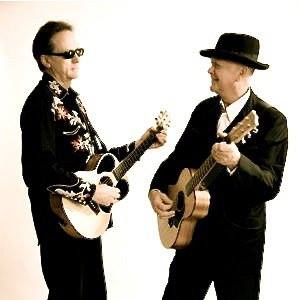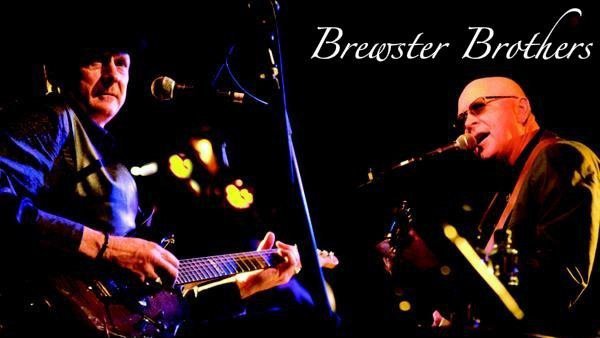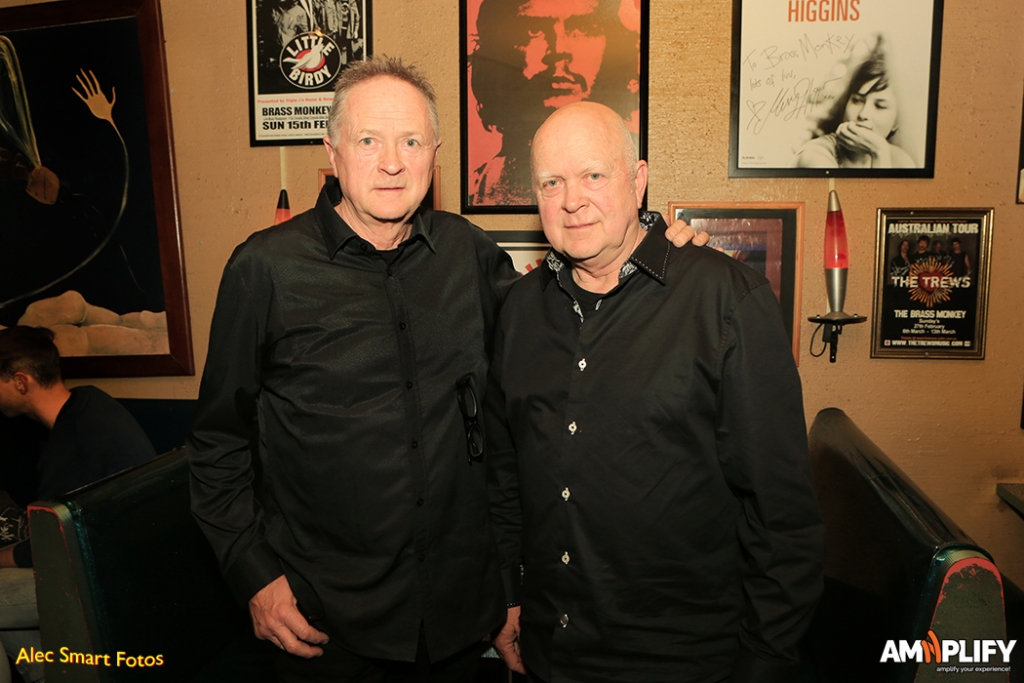Project Description
BREWSTER BROTHERS
@ Brass Monkey, Cronulla, Sydney
24/08/17 (Live Review)
Reviewer – Alec Smart
.
.
The Brewster Brothers appeared at the Brass Monkey in Cronulla, Sydney, on 24 August 2017 to promote their biographical book and accompanying 36-track CD, The Angels: Brothers, Angels and Demons.
John and Rick Brewster, the creative duo behind hit Australian rock band The Angels, played a selection of songs spanning their almost 50-year musical history, pausing between each for amusing anecdotes, many told by the long-term lighting director of their live shows, Raymond Hawkins, who accompanied them on stage.
Ray Hawkins is a witty and compelling raconteur, a natural counterbalance to the brothers’ shy reticence – they prefer to let their music speak. Hawkins revealed he met The Angels in the mid 70s, when they were relatively unknown. When he took on creating their stage lighting he employed imaginative techniques that were then unique, such as projecting striped lights on late vocalist Doc Neeson during the band’s 1979 No Exit album tour, which gave the impression he was behind prison bars.
.
.
Hawkins’ dynamic light shows drew the attention of other Australian bands, such as Midnight Oil and Cold Chisel, with whom he worked as production and tour manager, and eventually the Sydney Opera House, illuminating the Sydney Dance Company and Sydney Theatre Company for a decade. In recent years he’s taken to the back roads of Australia with his dog Ralph and a caravan hitched to an SUV, and publishes stories under the moniker The Electronic Swagman.
The Angels formed out of successful Adelaide pub act The Moonshine Jug and String Band. Jug bands, which pre-dated rock & roll and played skiffle music – a blend of blues, jazz and American folk, enjoyed a resurgence in the early 1970s, especially in Australia with the Captain Matchbox Whoopee Band from Melbourne.
Jug bands utilized a mix of conventional and homemade instruments, the latter adapted from ordinary household objects that made a sound, such as spoons, old washboards, a pole or guitar neck with vibrating strings attached to a container for amplification (such as a cigar box), combs covered with tissue paper (also known as a kazoo) and a jug that was blown into with vibrating lips (hence the name jug band).
.

Brewster Brothers, Brass Monkey, Cronulla, Sydney, Australia. Photo: Alec Smart, Thursday 24 August 2017
.
The Moonshine Jug and String Band was very popular among South Australian students and hippies, and between 1971, when Irish immigrant Doc Neeson joined, and 1974, they secured regular residencies at popular Adelaide venues. This is how the nucleus of the core creative trio came together – the Brewsters and Neeson, the latter of who became one of Australian rock’s most iconic stage performers.
When the jug band dissolved and reformed in 1974 with additional personnel, abandoning the declining skiffle trend to embrace the more popular rock ‘n’ roll, the Keystone Angels were born, later shortened to The Angels.
At the Brass Monkey, the Brewsters launched the night with two old Moonshine songs, Do It Again and If You’re A Viper, the latter about reefer smoking. In the original incarnation of the band, older brother John played banjo, guitar, harmonica, and washboard, while his younger sibling Rick alternated between jug, washboard, violin and percussion.
Household objects long discarded, John now plays acoustic guitar whilst Rick alternates between electronic keyboards and a Stratocaster electric guitar.
In 1976, The Angels signed a recording deal with Albert Records, to which they were recommended by Bon Scott and Malcolm Young, whose band, AC/DC were label mates and rising stars.
Alberts had been the home of two of Australia’s most prominent bands, The Easybeats and Billy Thorpe and The Aztecs, the former of which contained their in-house producers Harry Vanda and George Young, the latter of which was the elder brother of AC/DC’s Malcolm and Angus Young.
.
.
It was with Albert Records that The Angels released their first single, Am I Ever Gonna See Your Face Again in 1976, which, despite it first being issued as a ballad, and later a hard rock number with a catchy lead guitar intro, is now renowned for the expletive-laden audience response, ‘No Way, Get Fucked, Fuck Off!’, sung like a call-and-response after each line of the chorus.
The Brewsters opted not to play that number at their Brass Monkey appearance – perhaps because they preferred a more polite interaction with the audience.
Instead they began a familiar riff, typical of their early Angels’ songs, a style they call the ‘nik niks’, which consists of a jigger-jigger-jig, jigger-jigger-jig strumming on dampened strings that those familiar with the Angels will recognise on their early albums Face To Face, No Exit and Dark Room. Rick’s chart topping composition, Take A Long Line and John’s I ‘Aint The One followed, which typify this choppy guitar strumming style.
During banter with the audience, Rick was asked how he had managed to remain inanimate on stage during his long career performing with The Angels, although he was swaying now, perhaps more so than in his entire 43 years with the band.
Rick was renowned for standing stock-still, like a statue, which also included the infamous New Year’s Eve concert of 31 December 1979, later dubbed the Sydney New Year’s Opera House Riot, where he remained unscathed while some drunken hooligans in a crowd of 100,000 hurled objects at the band. Bassist Chris Bailey was hit in the forehead with a piece of sign whilst singer Doc Neeson was struck on the back of the head with a beer bottle. Both required hospitalisation and stitches, whereas Rick, Zen-like, merely tilted slightly back and forth to avoid the bottles as they flew past.
Rick, still wearing his trademark dark sunglasses (earlier in the night he was summoned to authorise my entry to the venue – mid-way through eating his dinner – and greeted me on the door, where I was surprised to find he was virtually unrecognisable without his dark shades) answered wryly that he kept so still for so many years to fulfil ‘a dare’.
.
.
Before the break, the brothers played Marseilles, the very track they performed during the aforementioned New Year’s Eve bottling incident, which, incidentally, ended all live rock concerts on the steps of the Opera House until Crowded House performed their farewell show there a decade later in November 1989.
During the break the brothers signed copies of their book The Angels: Brothers, Angels and Demons. They posed for photos with fans, and when I lined them up for a shot, I noticed with grim irony that the poster on the wall behind them advertised ‘Doc Neeson, Live’, from a concert he performed at this very venue before his premature death from a brain tumour in June 2014.
I repositioned the brothers so the poster wouldn’t show.
There was a time when considerable acrimony existed between the Brewsters and Neeson, the sides diverging into two rival line-ups of The Angels, before they set aside differences and reformed as one stable version in April 2008, which continued touring for another two years.
After the break the Brewsters returned to the stage with their former stage manager, Tony Grace, who spoke fondly of his relationship with the brothers, and Raymond Hawkins, the latter of whom regaled an amusing incident about when he witnessed a fan at a large Angels’ concert in Boulder, Colorado, fling a Frisbee from the back of the crowd towards the stage.
Hawkins picked it out with his spotlight as it sailed forwards, illuminating its progress, and just after John Brewster strummed the final song chord on his guitar and prepared to leave the arena, the Frisbee gently coasted up to him, whereupon he effortlessly plucked it from the air and coolly exited the stage.
John was then asked if one day on his travels, the greatest riff he would ever compose came suddenly into his head, yet just as he was about to write it down for future reference, he observed a woman lose her grip on a young child that risked falling down a drain. What would he do, help and forget the riff or ignore the child to write it down?
.
.
John drolly replied, ‘Here is the riff!” before striking the opening chords of Face The Day from The Angels’ 1980 album Dark Room, a best-selling song at the time, although, in my humble opinion, not his greatest riff.
The Brewsters come from music royalty. While John’s son Sam continues the musical legacy and plays in the latest incarnation of The Angels, John and Rick’s grandfather, Hooper Brewster-Jones, was a concert pianist, composer and founder of the first Adelaide Symphony Orchestra. Their father, Arthur Brewster-Jones, also conducted the Adelaide Symphony Orchestra and played as their first cellist before becoming Director of Classical Music at the Australian Broadcasting Corporation.
The duo completed their set with a few Brewster Bros compositions, Tide and Time, the haunting Blue Blood, and an extended version of Passing Through, before the band left then returned for a rousing encore with two Bob Dylan compositions, Don’t Think Twice it’s Alright and All Along the Watchtower. These also feature on the Brewster’s own album of Dylan covers.
.
Check out The Angels infamous 31 Dec 1979
New Year’s Eve concert at the Sydney Opera House below.
.
Follow THE BREWSTER BROTHERS
Website Facebook
.











